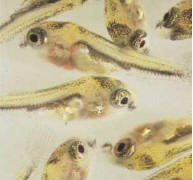GENERAL PRINCIPLES
Most fish kept by aquarists are oviparous (egg-layers), but there are some exceptions
- viviparous fish (or livebearers).
 A varied and rich
diet enables fish to accumulate reserves of proteins and lipids, which help them
form eggs and spermatozoa. This is the maturing phase. When the female's ovary swells,
she is ready to lay eggs. This only needs a stimulus to trigger it off, such as,
in the natural setting, rain, sunlight, or moonlight (research is presently in progress
on the influence of the moon on reproduction). In an aquarium, egg-laying is sometimes
sparked off by the early morning sunlight, which beats down on the tank with varying
degrees of intensity, or by a partial change of water. A varied and rich
diet enables fish to accumulate reserves of proteins and lipids, which help them
form eggs and spermatozoa. This is the maturing phase. When the female's ovary swells,
she is ready to lay eggs. This only needs a stimulus to trigger it off, such as,
in the natural setting, rain, sunlight, or moonlight (research is presently in progress
on the influence of the moon on reproduction). In an aquarium, egg-laying is sometimes
sparked off by the early morning sunlight, which beats down on the tank with varying
degrees of intensity, or by a partial change of water.
The laying of eggs can be preceded by a courting ritual, during which the male
seduces the female or, in rare cases, bullies her and violently sees off any rivals.
The female then expels her eggs into the water, and these are immediately fertilized
by the male.
This is obviously only a general description that leaves room for the huge diversity
found in aquarium fish, particularly as regards the future fate of the eggs: they
can be abandoned, or even sometimes eaten, by their parents, or they can be guarded
and defended in the first days of their life, and a similar variety of parental
behavior is found in the treatment of the developing fry.

The incubation of the eggs, which lasts several days, sees the development of
the embryo. When this is completely formed, it moves about until it breaks the egg's
membrane: this is the hatching. A larva emerges, differing from an adult in its
form, size, and the proportion of certain organs. The larva has highly developed
eyes, for instance, allowing it to spot its prey. It also has a vitellin vesicle,
which provides it with food reserves during the first days following its emergence
from the egg (except in livebearers of the Poeciliid family).
The larva gradually evolves, over the course of a few days or weeks, depending
on the species, and modifies its behavior to become more and more like an adult.
It turns into fry.

Some fish lay their eggs on a horizontal support, then ventilate
and protect them from the rapaciousness of other species.
THE VITELLIN SACK
The vitellin sac, or vitellin vesicle, constitutes the fish larva's food reserves
in the first days of its life. It derives from the vitellin of the egg - the equivalent
of the yolk in poultry - accumulated by the female over the course of the maturing
process. It is sent along the blood vessels, which distribute these reserves around
the body of the larva. This allows it to survive until it is able to catch prey
itself, i.e. a few days after emerging from the egg.

The vitellin sack of these 15-day-old larvae has been practically
all used up.
THE REARING TANK
This is normally modest in size, as it is used to isolate a pair of reproducing
fish and their future offspring. There is no need for a bed, except for some species
(the Cichlasomas, for example). A rearing tank must be heated but only moderately
filtered. Avoid any systems which may "swallow" the eggs and the fry. Aeration is
not obligatory. Fill the tank with water taken from the parents' aquarium, which
can then be gradually modified to obtain the precise characteristics required by
the reproducing fish (pH and hardness). A support should be provided for the egg-laying,
and this can be either natural (plants, rocks) or artificial (PVC). More detailed
information on this subject, family by family, can be found below.

This female Cichlid, which incubates her eggs in her mouth,
finds greater peace in a rearing tank.
|